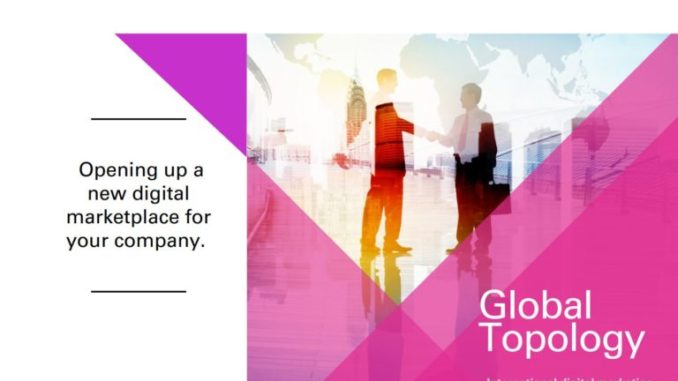
30-second summary:
Based in the Netherlands, Global Topology (GT) is an international digital marketing company with expertise in digital export marketing.
Their new whitepaper, Opening up a new digital marketplace for your company, contains essential information about opportunities for digital expansion post-COVID.
Successfully entering new markets requires a comprehensive and strategic approach that includes an international digital marketing strategy, knowledge of where your product or service fits into a specific market, an understanding of international logistics
Download the free whitepaper, Opening up a new digital marketplace for your company from ClickZ for more detailed information on global export expansion.
Based in the Netherlands, Global Topology (GT) is an international digital marketing company with expertise in digital export marketing. Their new whitepaper, Opening up a new digital marketplace for your company, contains essential information about opportunities for digital expansion post-COVID.
Successfully entering new markets requires a comprehensive and strategic approach that includes an international digital marketing strategy, knowledge of where your product or service fits into a specific market, and an understanding of international logistics.
In this post, we’ll unpack some of the main highlights of the new whitepaper, which you can download for free from here.
Content created in partnership with Global Topology.
The importance of digital marketing strategy
Expanding globally starts with developing a strategy. Global Topology recommends beginning by researching countries to determine where there is a market (or not) for your products or services. Research will help you identify competitors and gain an understanding of the needs and characteristics of each market.
Writes GT, “A marketing entry strategy based on your new market will help you position your products or services in the right channels and in the right way. This applies both to B2B and B2C.”
Details to consider when researching global export markets include:
Product marketing fit for each country—Review the vertical market opportunities, competitors, language, and culture issues. When possible, test the market. This is also a good way to begin establishing trust and credibility.
Roll out your product in one country at a time—This enables you to focus on each market individually, particularly since it can take longer to establish a foothold in markets outside of your own country.
Europe is more than one market—Remember, Europe is a multi-cultural, multi-lingual market. Approach it as such.
Plan for logistics—If you’re exporting goods, you’ll need to understand the logistics process for each country including transportation, customs, taxes, legislation, and cost. Do you have staff that can speak the native language in countries where you plan to sell services or software?
English is not enough
Global Topology’s whitepaper emphasizes the importance of speaking a country’s native language when expanding into a new market. This extends to your website, which may include variations of English (e.g., U.K., US, Indian, etc.) and your staff, which should be able to handle questions and concerns from people in their native language.
Writes GT, “Make sure your staff is trained in handling questions in new languages and from other parts of the world and with a different cultural background. This also might implicate thinking in different time zones and working hours.”
Here are a few tips to consider when incorporating different languages into your global expansion strategy:
Make your language choices based on market volumes.
Avoid the temptation of Google Translate. Instead, work with native language speakers when creating websites and other content for your new markets.
Go beyond translation to localization—that is, use local terms and jargon to help your visitors feel at ease.
Language is a natural extension of a country’s culture, and GT advises businesses that being incredibly familiar with cultural differences is a key to achieving success in new markets.
“Based on cultural aspects like power distance, individualism, masculinity, uncertainty avoidance, long term orientation, and indulgence, people make decisions; businesses make decisions,” Writes GT.
One website or many?
Your website will be your biggest global asset when expanding to new markets, particularly now since travel is so limited. An important consideration when developing your international expansion approach will be to determine what form your site should take: global, local, or hybrid.
Here’s a brief overview of each:
Global: One-size fits all/targets the world as one community. The most cost-effective option, this requires just one website in a single language, but it can also alienate new markets. After all, it only works if your target audience speaks your language.
Hybrid: This approach still requires only one website with a single set of visual assets, but it incorporates sections for specific countries/markets that are written in the markets’ native languages. Writes GT, “A hybrid strategy combining financial benefits and the overall control (from HQ) on content, is the most used model.”
Localized: This approach requires creating unique websites for each market/language, the best choice if you’re expanding into 2-10 markets. This is also an effective strategy when your markets are quite different, since it’s easier to address cultural differences in tone, design, and approach with unique websites. Sentiments about individualism, masculinity, and long-term orientation can vary widely from market to market, as the following graph illustrates:
Reaching new markets through international campaigning
It’s important to understand your target market from their own perspective. Global Topology recommends working with people from the inside of each market so they can effectively help you understand what channels the local audience prefers, how they use them, and how they shop and do business.
The whitepaper covers nuances about running international SEO, PPC, and social campaigns and includes two relevant case studies.
Writes GT, “International campaigning and opening up new markets means cooperation with local partners. They understand the local culture best, and speak the language.”
Download the free whitepaper, Opening up a new digital marketplace for your company from here for more detailed information on global export expansion.
The post Digital transformation post-COVID presents huge opportunities for global export expansion appeared first on ClickZ.
Source: ClickZ
Link: Digital transformation post-COVID presents huge opportunities for global export expansion


